Swimming meditation combines the physical benefits of swimming with mindfulness techniques to help you manage anxiety effectively. You'll sync your breathing with fluid movements while focusing on the sensations of water against your skin. This practice reduces stress hormones, triggers endorphin release, and activates your body's natural relaxation response. Start in the shallow end with short 5-10 minute sessions, practicing rhythmic breathing and gentle strokes while maintaining present-moment awareness. As you establish a consistent practice three times per week, you'll develop stronger mental resilience and emotional regulation. The depths of this calming practice hold even more healing potential.
Understanding Swimming Meditation
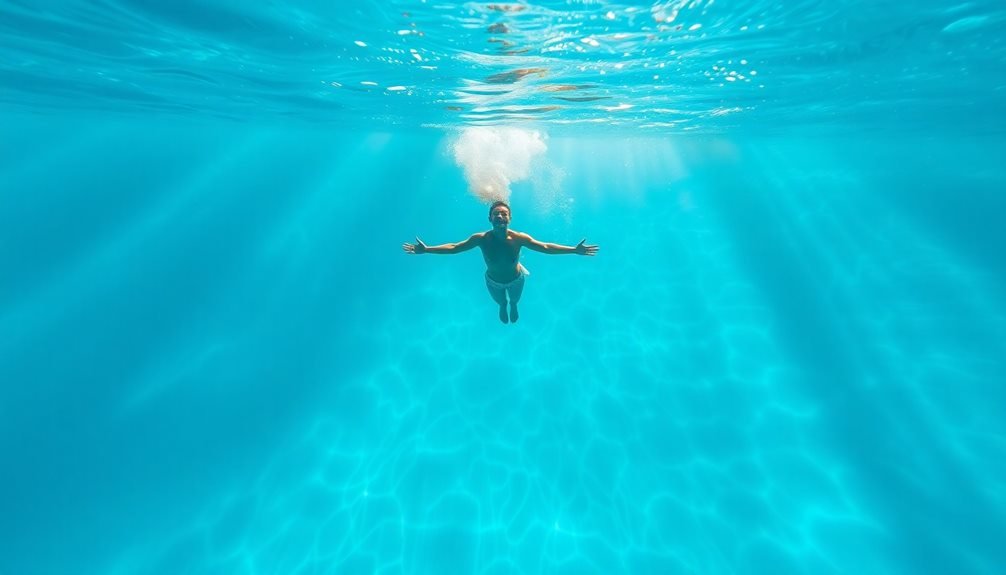
Swimming meditation combines the physical benefits of swimming with mindfulness techniques to create a unique form of moving meditation. Unlike traditional meditation, where you sit still, this practice engages your entire body while maintaining a focused, present-moment awareness.
You'll find yourself paying attention to your breathing rhythm, the sensation of water against your skin, and the fluid movements of your strokes.
The practice draws from both athletic swimming principles and meditation fundamentals. You'll learn to synchronize your breath with your movements, similar to how yogis coordinate breath with poses.
As you glide through the water, you'll focus on the immediate sensations: the temperature around you, the sound of bubbles, and the gentle resistance of the water. This sensory awareness helps quiet your racing thoughts.
What makes swimming meditation particularly effective is the water's natural ability to dampen external stimuli. The pool becomes your sanctuary, where outside noise fades away.
You'll develop a heightened awareness of your body's position, movement, and internal state, creating a meditative experience that can considerably reduce anxiety levels while improving physical fitness.
Benefits For Mental Wellness
The mental health advantages of swimming meditation extend far beyond basic stress relief. When you combine mindful breathing with rhythmic swimming movements, you'll experience a significant reduction in anxiety levels and racing thoughts. The water's natural resistance helps ground you in the present moment, making it harder for worried thoughts to take hold.
You'll notice improved emotional regulation as swimming meditation activates your body's relaxation response. The repetitive nature of swimming strokes, paired with controlled breathing, triggers the release of endorphins and reduces cortisol levels in your system. This combination helps stabilize your mood and creates a natural barrier against depression and anxiety.
The practice strengthens your mental resilience by teaching you to focus on the immediate sensations of water, movement, and breath. You'll develop better concentration skills as you learn to tune out distractions and maintain awareness of your body's position in the water.
The meditative aspects of swimming also boost your self-awareness, helping you recognize and address stress triggers before they escalate into overwhelming anxiety.
Getting Started In The Water
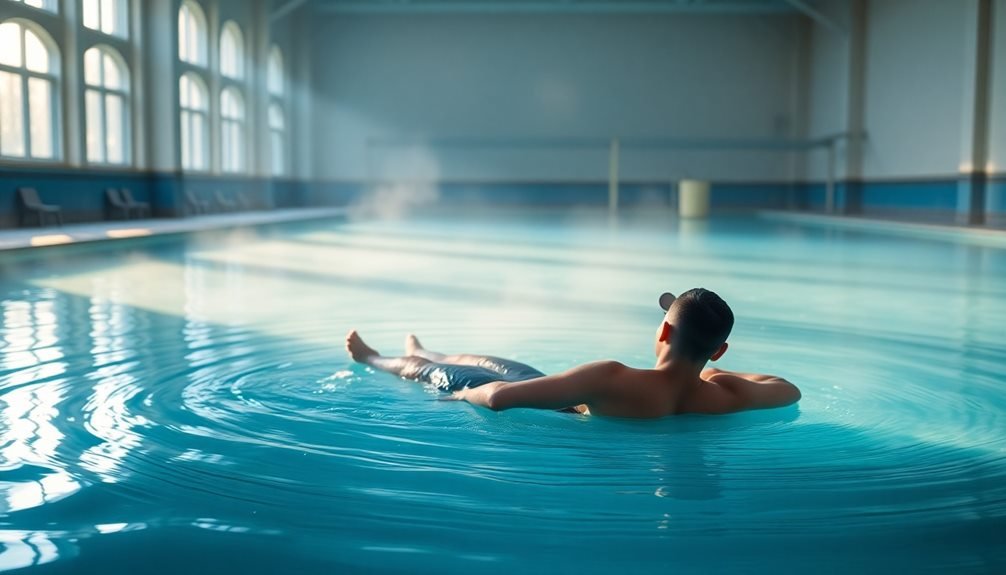
Before diving into swimming meditation, you'll need to establish a comfortable foundation in the water. Start in the shallow end where you can easily touch the bottom, and take several deep breaths to acclimate yourself to the pool's environment. Focus on feeling secure and relaxed in your chosen space.
Begin with basic floating exercises to build trust in the water's natural buoyancy. Lie on your back, letting your ears submerge while keeping your face above water. If you're new to floating, use pool noodles or kickboards for extra support until you develop confidence.
Once you're comfortable floating, practice rhythmic breathing by turning your head to the side while maintaining a horizontal position. Inhale when your face is out of the water, and exhale slowly when your face turns back in. This breathing pattern forms the foundation of swimming meditation.
Start with short sessions of 5-10 minutes, gradually increasing duration as you become more comfortable. Remember to maintain a water temperature between 78-82°F (26-28°C) for ideal relaxation, and always guarantee there's a lifeguard or swimming buddy present for safety.
Essential Breathing Techniques
Mastering your breathing rhythm while swimming is essential for achieving a meditative state, so you'll want to start with slow, deep breaths that match your swimming strokes.
You can practice this by inhaling for four strokes and exhaling for four strokes, creating a natural, calming pattern.
For an advanced technique, try alternate nostril breathing during your pool meditation sessions by rotating which nostril you use to inhale as you swim, which helps balance your nervous system.
Rhythm of Deep Breaths
Proper breathing rhythm serves as the foundation for effective swimming meditation. When you're in the water, your breathing pattern needs to match your swimming movements to maximize both relaxation and oxygen efficiency. You'll find that coordinating your breath with your strokes creates a natural, meditative state that helps dissolve anxiety.
To establish a calming breathing rhythm, focus on these key elements:
- Inhale for a count of four seconds as you glide through the water, allowing your lungs to fully expand while maintaining a smooth swimming motion.
- Hold your breath for two seconds at the peak of inhalation, creating a moment of stillness that anchors your mind to the present.
- Exhale slowly for six seconds as you continue your stroke, releasing tension with each breath while maintaining consistent movement.
Your breathing shouldn't feel forced or uncomfortable. Instead, it should flow naturally with your swimming pace. As you practice, you'll notice your body automatically settling into this rhythm, making it easier to maintain the meditative state.
If you feel any discomfort, adjust the counting to match your natural breathing capacity.
Alternate Nostril Breathing Underwater
Alternate nostril breathing brings an advanced dimension to your underwater meditation practice. While you can't physically alternate nostrils underwater, you'll adapt this technique by focusing on imagining the alternating flow of breath through each side of your nose as you swim.
| Stroke Phase | Breathing Focus |
|---|---|
| Pull | Right nostril |
| Glide | Hold breath |
| Recovery | Left nostril |
| Entry | Complete cycle |
To practice this technique, you'll start by swimming at a comfortable pace. As you execute each stroke, visualize breathing through your right nostril during the pull phase. During the glide, hold your breath naturally. When you move into the recovery phase, imagine the breath flowing through your left nostril. Complete the cycle as your arm enters the water.
This rhythmic breathing pattern helps balance the left and right hemispheres of your brain while swimming. You'll notice reduced anxiety as you sync your breath with your strokes. Remember to maintain a steady pace and don't force the breathing pattern – let it flow naturally with your movement through the water.
Mindful Swimming Movements
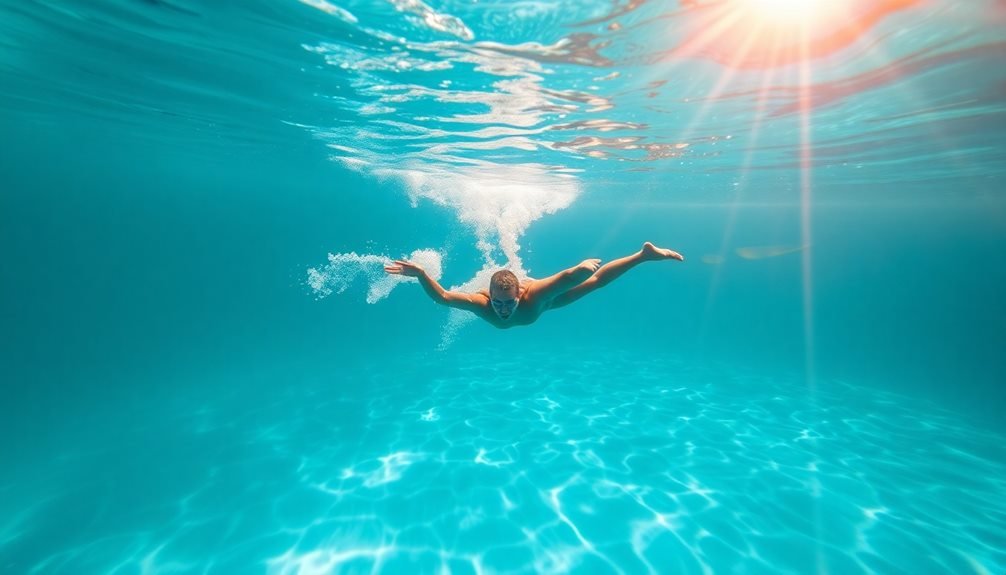
As you move through the water, sync your rhythmic breathing with each stroke to create a natural, meditative flow.
You'll notice how the water's gentle resistance guides your movements, allowing you to focus entirely on the sensation of gliding forward.
Let your mind connect with the water's flow around your body, paying attention to how it feels against your skin with each coordinated movement.
Rhythmic Breathing While Swimming
Synchronized breathing in accordance with your swimming strokes creates a meditative state that naturally reduces anxiety. As you glide through the water, focus on establishing a consistent breathing pattern that matches your movement. This rhythmic coordination helps quiet your racing thoughts and brings your attention to the present moment.
To master anxiety-reducing breathing while swimming:
- Start with a basic freestyle breathing pattern – inhale every third stroke, turning your head to the side just enough for your mouth to clear the water's surface. This creates a steady, predictable rhythm that calms your nervous system.
- Practice bilateral breathing by alternating sides every third stroke, which balances your body mechanics and deepens your meditative state. You'll find your mind settling into this natural rhythm.
- Gradually extend your exhalation underwater, releasing bubbles slowly through your nose. This longer exhale triggers your parasympathetic nervous system, reducing stress hormones and promoting relaxation.
Remember to keep your breathing smooth and controlled, never forcing or rushing it. When you feel anxious, return your focus to this rhythmic breathing pattern, letting it anchor you in the present moment.
Focus on Water Flow
The gentle flow of water against your body offers another powerful dimension to swimming meditation. As you swim, focus on how the water moves across your skin, creating a sensory experience that anchors you to the present moment. You'll notice different sensations as you glide through the water, each movement creating unique patterns of pressure and resistance.
Pay attention to these water interactions during your swim:
| Body Part | Sensation | Mindful Focus |
|---|---|---|
| Fingertips | Cutting through water | Leading with intention |
| Torso | Smooth gliding | Core stability |
| Legs | Propelling force | Power and rhythm |
| Face | Cool pressure | Sensory grounding |
Let the water's resistance become your teacher. When you feel it pushing against your palms, notice how it helps you move forward. The pressure against your face during breaths can serve as a reminder to stay present. You'll find that focusing on these water sensations naturally quiets anxious thoughts, as your mind becomes absorbed in the immediate physical experience of swimming through the liquid environment.
Building Your Daily Practice
Starting small and building consistency is key to establishing your swimming meditation routine. Begin with just 10-15 minutes of mindful swimming three times a week, then gradually increase your sessions as you become more comfortable with the practice.
You'll find it easier to maintain your commitment when you schedule your swimming meditation at the same time each day, whether it's early morning or during your lunch break.
To create a sustainable practice, follow these essential steps:
- Choose a consistent swimming location where you won't be interrupted and can focus on your meditation.
- Set realistic goals that match your current fitness level and schedule, adjusting them monthly.
- Track your progress in a meditation journal, noting how you feel before and after each session.
Remember to listen to your body and adjust your practice accordingly. If you're feeling particularly anxious, you might need longer sessions.
On days when you're pressed for time, even a brief 10-minute swim can help center your thoughts. The key is maintaining regularity rather than perfection, so don't be too hard on yourself if you miss a day occasionally.
Frequently Asked Questions
Can Swimming Meditation Help With Chronic Pain Conditions?
You'll find swimming meditation can help manage chronic pain through gentle movement, water's buoyancy, and mindfulness. It reduces physical stress on joints while promoting relaxation and natural pain-relieving endorphins in your body.
What Should I Do if I Experience Panic During Swimming Meditation?
If you're panicking while swimming, immediately return to shallow water or pool's edge. Focus on slow breathing, remind yourself you're safe, and pause the meditation. Don't hesitate to seek help from lifeguards.
Is Swimming Meditation Safe for Pregnant Women?
You should consult your doctor before trying swimming meditation while pregnant. While swimming's generally safe during pregnancy, you'll need specific guidance based on your trimester, health status, and any pregnancy complications.
How Does Chlorine Exposure Affect the Meditative Benefits of Swimming?
You'll still gain meditative benefits while swimming in chlorinated pools, but strong chemical smells can distract your focus. Consider outdoor natural bodies of water or salt water pools for a more peaceful experience.
Can I Practice Swimming Meditation in Open Water Environments?
Yes, you can meditate while swimming in open water, but you'll need extra safety precautions. Always swim with a buddy, check conditions beforehand, and stay near the shore in calm, familiar waters.
In Summary
You've now learned how swimming meditation can transform your anxiety into tranquility. Take these techniques with you to the pool, lake, or ocean – they're your tools for finding peace in the water. Remember to start slowly, focus on your breath, and be patient with yourself. As you continue practicing, you'll discover that swimming meditation isn't just exercise; it's your path to mental clarity and emotional balance.

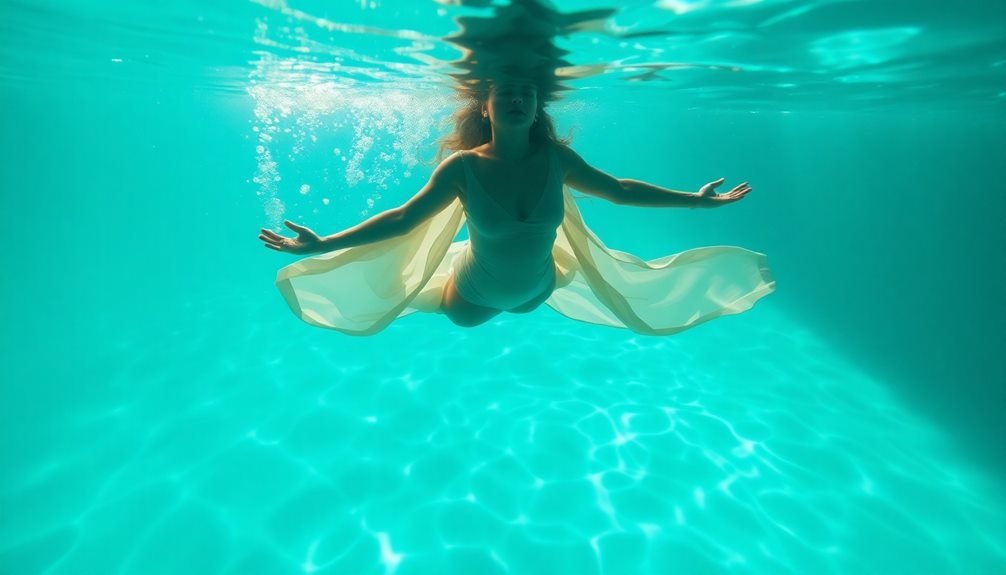

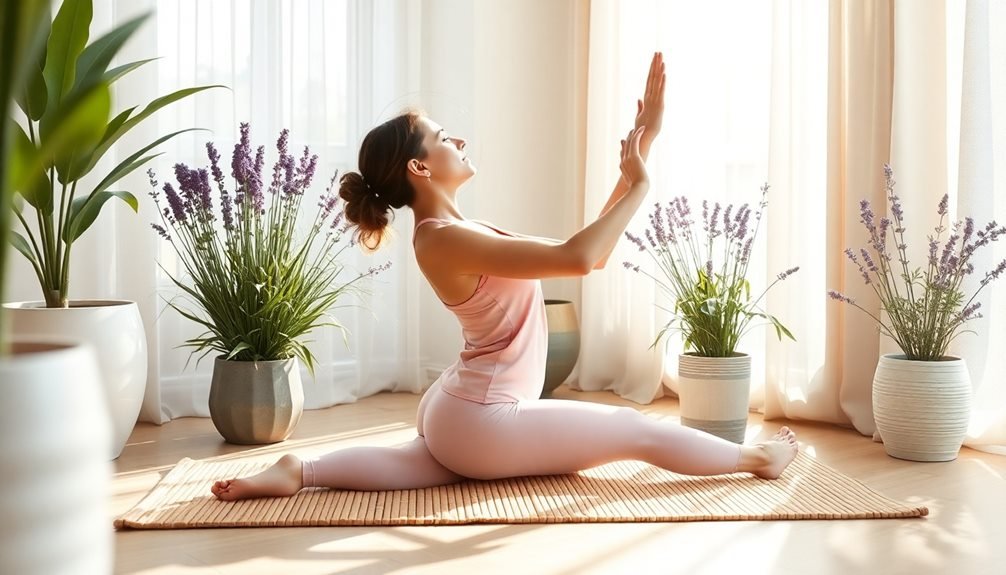
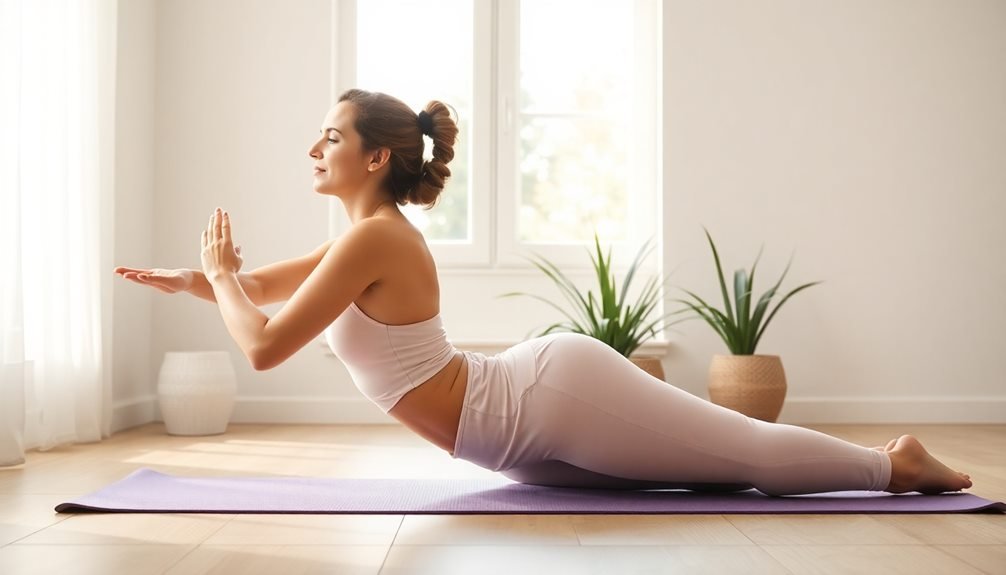
Leave a Reply